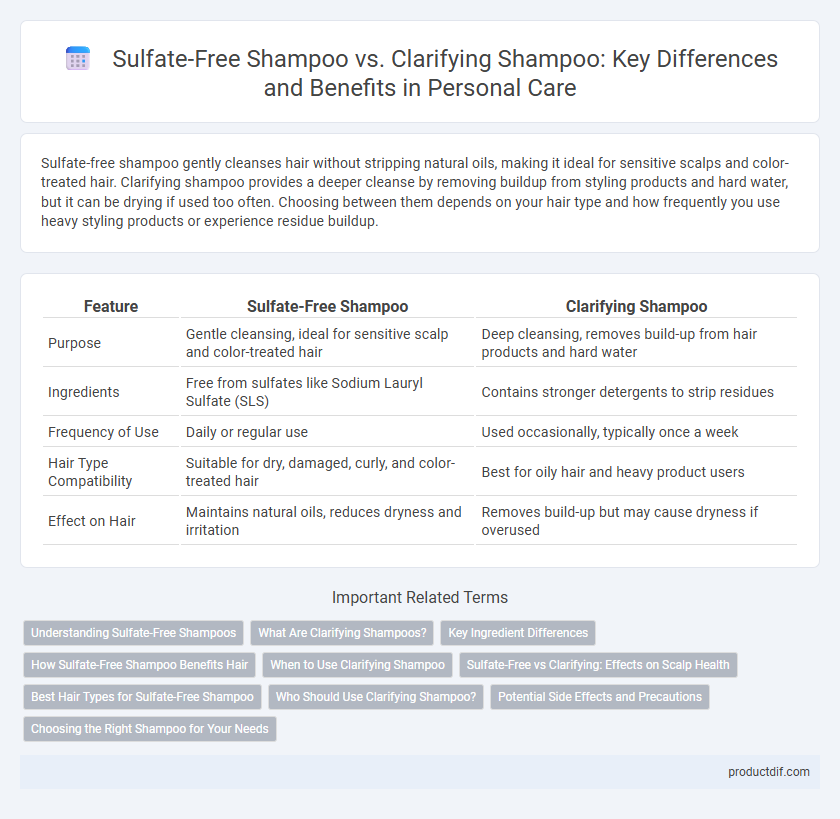Sulfate-free shampoo gently cleanses hair without stripping natural oils, making it ideal for sensitive scalps and color-treated hair. Clarifying shampoo provides a deeper cleanse by removing buildup from styling products and hard water, but it can be drying if used too often. Choosing between them depends on your hair type and how frequently you use heavy styling products or experience residue buildup.
Table of Comparison
| Feature | Sulfate-Free Shampoo | Clarifying Shampoo |
|---|---|---|
| Purpose | Gentle cleansing, ideal for sensitive scalp and color-treated hair | Deep cleansing, removes build-up from hair products and hard water |
| Ingredients | Free from sulfates like Sodium Lauryl Sulfate (SLS) | Contains stronger detergents to strip residues |
| Frequency of Use | Daily or regular use | Used occasionally, typically once a week |
| Hair Type Compatibility | Suitable for dry, damaged, curly, and color-treated hair | Best for oily hair and heavy product users |
| Effect on Hair | Maintains natural oils, reduces dryness and irritation | Removes build-up but may cause dryness if overused |
Understanding Sulfate-Free Shampoos
Sulfate-free shampoos are formulated without harsh detergents such as sodium lauryl sulfate, which can strip natural oils and cause scalp irritation. These shampoos preserve moisture balance, making them ideal for sensitive scalps and chemically treated hair. Their gentle cleansing action supports healthier hair by maintaining natural oils and minimizing dryness.
What Are Clarifying Shampoos?
Clarifying shampoos are designed to deeply cleanse hair by removing buildup from oils, styling products, and hard water minerals, providing a fresh and revitalized scalp. Unlike sulfate-free shampoos, which focus on gentle cleansing without stripping natural oils, clarifying shampoos use stronger surfactants to deliver a more intensive purification. Regular use of clarifying shampoo is recommended for those with oily hair or frequent product buildup to maintain hair health and shine.
Key Ingredient Differences
Sulfate-free shampoos primarily rely on gentle surfactants like cocamidopropyl betaine and decyl glucoside, which effectively cleanse hair without stripping natural oils or causing irritation. Clarifying shampoos contain stronger detergents such as sodium laureth sulfate or ammonium lauryl sulfate, designed to remove heavy buildup from styling products, hard water minerals, and oils. The key ingredient difference lies in sulfate presence, influencing each shampoo's cleansing strength and impact on hair moisture balance.
How Sulfate-Free Shampoo Benefits Hair
Sulfate-free shampoo effectively cleanses hair without stripping natural oils, preserving moisture and preventing dryness or irritation commonly caused by harsh sulfates. This gentle formula is ideal for sensitive scalps and color-treated hair, maintaining vibrancy and reducing the risk of damage or fading. Regular use enhances hair softness, strength, and overall health by minimizing protein loss and retaining essential nutrients.
When to Use Clarifying Shampoo
Clarifying shampoo is ideal for removing residue buildup from styling products, hard water minerals, and excess oils, restoring hair's natural shine and softness. Use clarifying shampoo once every one to two weeks to deeply cleanse without stripping essential moisture, especially if regularly exposed to heavy products or environmental pollutants. Avoid frequent use on color-treated or dry hair, as its strong formulation can cause dryness and color fading.
Sulfate-Free vs Clarifying: Effects on Scalp Health
Sulfate-free shampoos gently cleanse the scalp without stripping natural oils, reducing irritation and dryness for sensitive skin. Clarifying shampoos provide a deep clean by removing buildup from styling products and excess oil, which can prevent clogged pores and dandruff but may cause dryness if used frequently. Choosing between sulfate-free and clarifying shampoos depends on individual scalp needs, balancing hydration with the necessity of removing impurities.
Best Hair Types for Sulfate-Free Shampoo
Sulfate-free shampoo is best suited for individuals with dry, damaged, or color-treated hair, as it gently cleanses without stripping natural oils or causing color fade. It is also ideal for sensitive scalps prone to irritation since it avoids harsh cleansing agents found in traditional shampoos. Those with curly or frizzy hair benefit from sulfate-free formulas that help maintain moisture and enhance hair texture without excessive dryness.
Who Should Use Clarifying Shampoo?
Clarifying shampoo is ideal for individuals with oily scalp, frequent product buildup, or those who swim regularly in chlorinated water, as it deeply cleanses and removes residues that regular shampoos cannot. People who use styling products daily or live in urban areas with heavy pollution benefit from clarifying shampoos to restore scalp balance and hair shine. Those with color-treated or dry, sensitive hair should use clarifying shampoos sparingly to avoid stripping natural oils and causing dryness.
Potential Side Effects and Precautions
Sulfate-free shampoos minimize scalp irritation and reduce hair dryness, making them ideal for sensitive skin and color-treated hair but may cause buildup if not used regularly. Clarifying shampoos effectively remove product residue and excess oils but can strip natural oils, leading to dryness, scalp irritation, or increased hair fragility with frequent use. It is essential to limit clarifying shampoo use to once a week and follow up with moisturizing treatments to maintain scalp and hair health.
Choosing the Right Shampoo for Your Needs
Sulfate-free shampoo is ideal for individuals with sensitive scalps or color-treated hair, as it cleanses gently without stripping natural oils. Clarifying shampoo offers a deeper cleanse, effectively removing buildup from styling products and hard water but should be used sparingly to avoid dryness. Selecting the right shampoo depends on your hair type, scalp condition, and frequency of product buildup to maintain optimal hair health.
Sulfate-Free Shampoo vs Clarifying Shampoo Infographic

 productdif.com
productdif.com